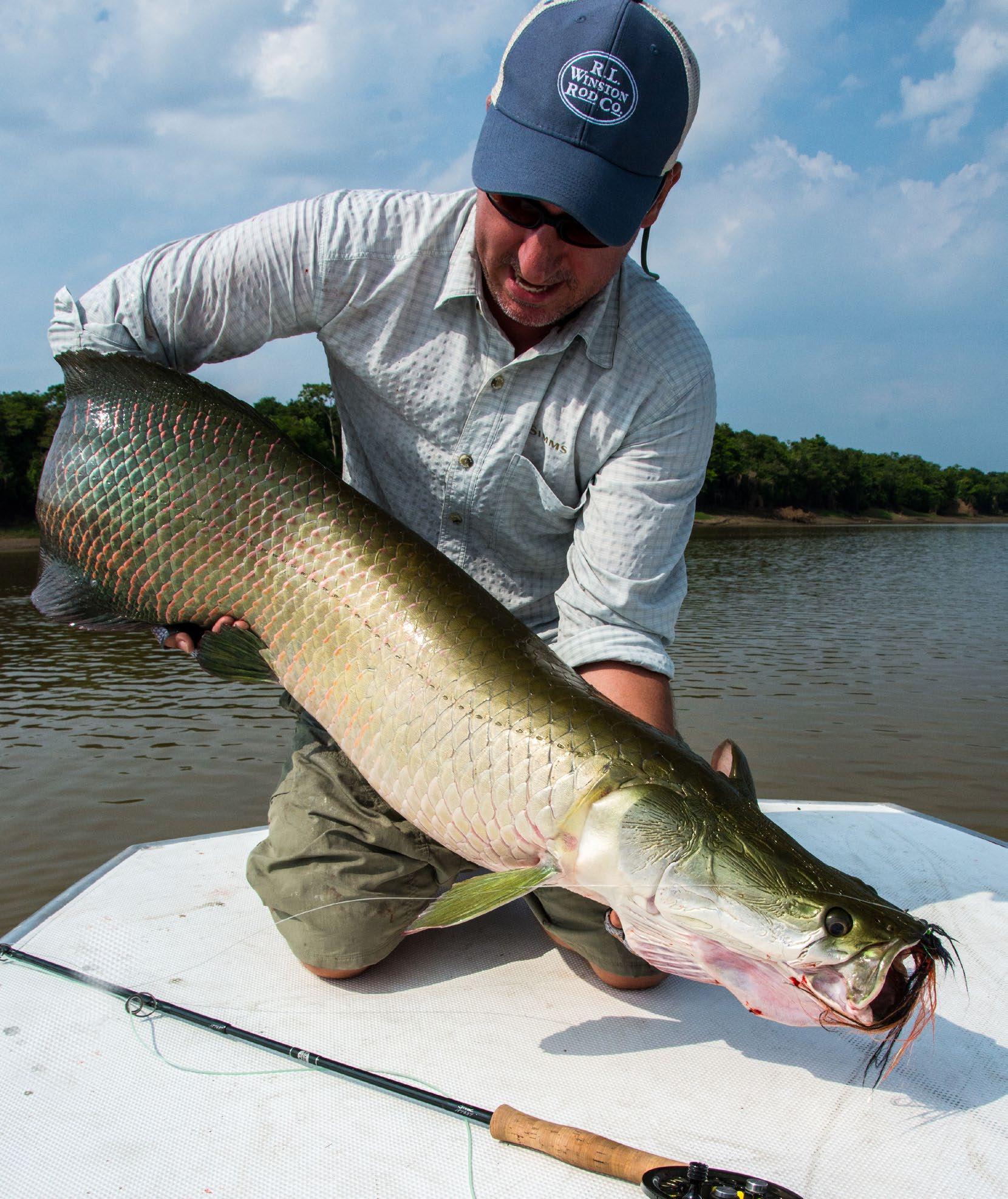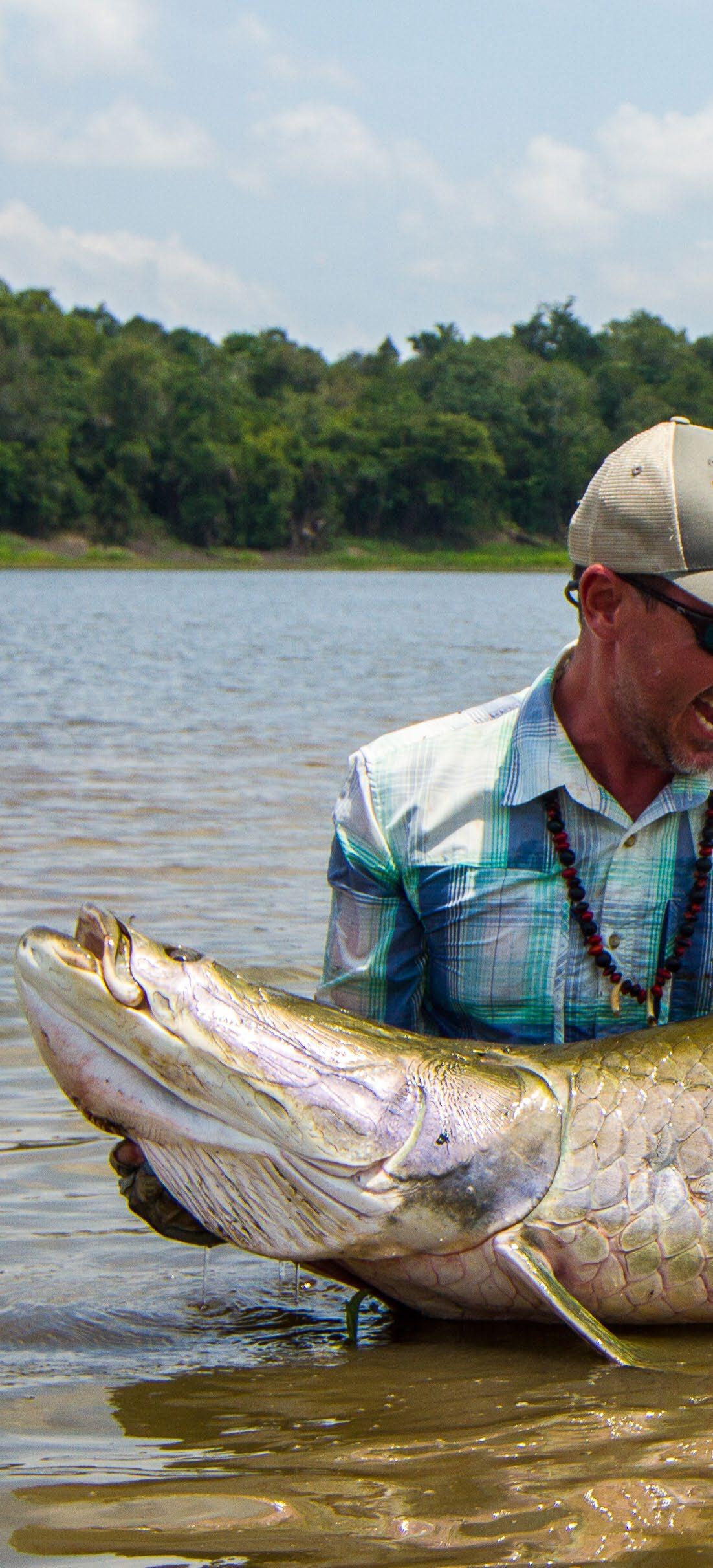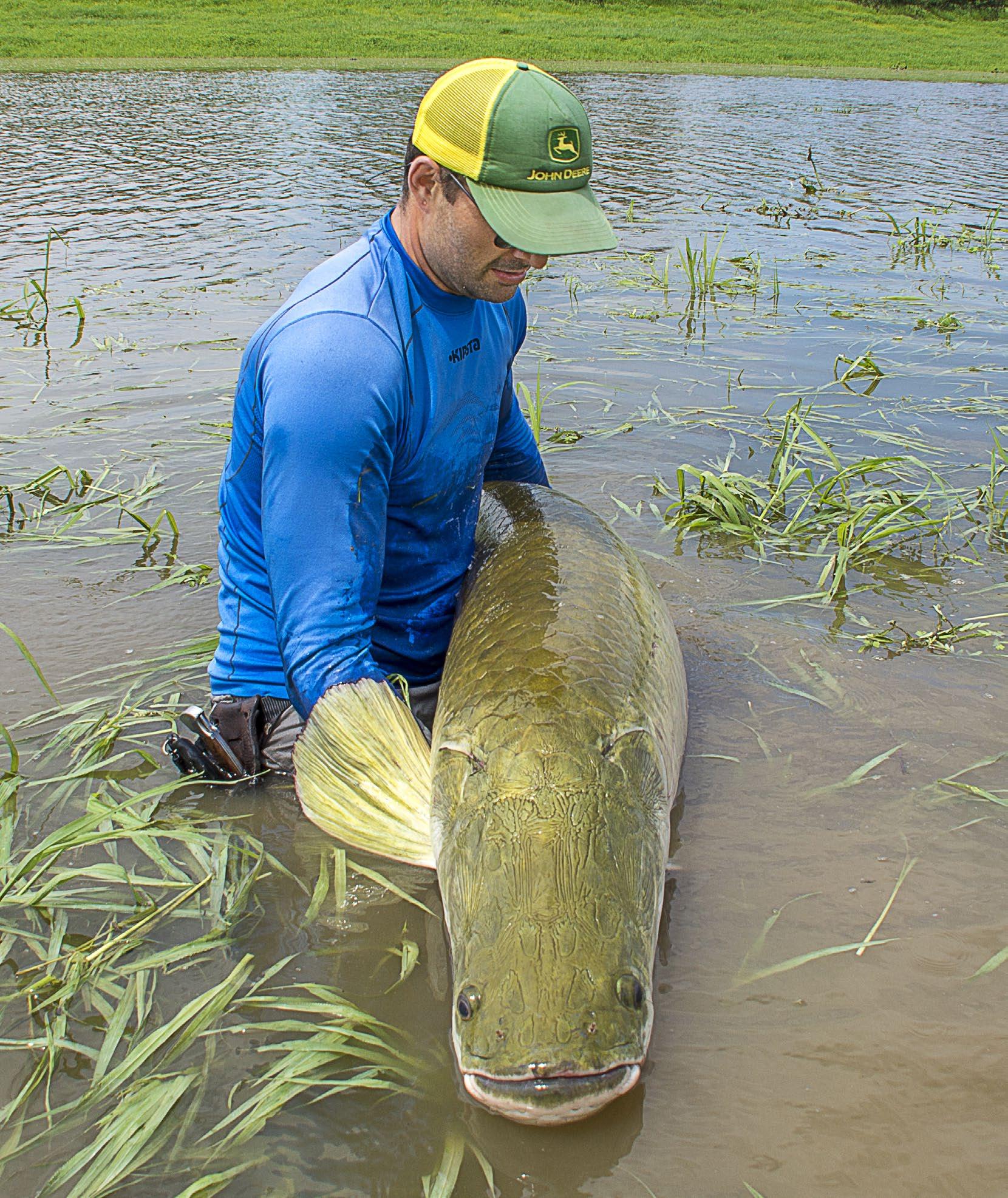
15 minute read
Arapaima: The Spirit of the Jungle
“Pirarucu” means “the red fish” in the local Indian language, and it’s the name of the biggest freshwater fish of the Amazon – the Arapaima (Arapaima Gigas).
By RODRIGO SALLES Photography by RODRIGO SALLES, RAFAEL COSTA and UNTAMED ANGLING

I remember seeing monstrous arapaima in old books and local fishing magazines as a child. Especially an image of a 2,5 meter long arapaima hanging from a tree with a man standing beside it looking really small, stayed in my mind.
I grew up fishing for freshwater Dorado in southwest Brazil, and geographically, those fascinating pirarucu were completely out of reach. However, I always knew I would overcome the distances! To begin with, I started thoroughly researching the arapaima: Read all articles and books I came across. The information, however, was very superficial and scarce. It was only in a few biology books that I was able to find any relevant data and information.
The arapaima can reach weights in excess of 250kgs and lengths of more than 3 meters. It is a carnivorous fish with one of the highest growth rates among freshwater fish. It will devour anything from insects and crustaceans (in their juvenile stages), to baitfish like piranhas and even small peacock bass. Its distribution area stretches through the northern and eastern Amazon into the Amazon River basin, Solimoes, Japura, Negro and Madeira. It is also found in the basin of the Rio Araguaia - Tocantins in central Brazil.
Wild arapaima migrate between different environments in the Amazonian floodplain according to the seasonal water level fluctuations. During the dry season, the fish mainly inhabit the lakes, but also the Parana environments and river channels. At the beginning of the flood season aquatic environments begin to connect. For a while, the arapaima will continue to inhabit the lakes and paranás but they also start to migrate into new lakes and lagoons via channels and creeks. During the rainy season - as the water levels continue to rise, the arapaima migrates to the flooded forests, which are rich in nutrients. Once the water starts to drop again, the arapaima is then forced to migrate out of the flooded forests, which dry up.

Reproduction
The pirarucu form couples for spawning during the low water season in the lakes. At the beginning of the flood season, when the water is approximately 1 meter deep, the pirarucu couples build their nests on the banks of the marshes surrounding the lakes, channels and lagoons.
The female lays eggs in the nest and the male fertilizes them. Usually the male takes care of the alevin and juveniles for about three months in the flooded forests.
At the end of the first year of their lives, the arapaima will have reached more than 80 cm in length and when it’s five years it will measure more than 188 cm. According to scientific studies from the Mamirauá Reserve, the arapaima reproduces from the age of three when it is approximately 150 cm in length.

Tarpon vs. Arapaima
Personally, I believe that there is an ancestral relationship between tarpon and arapaima. They are quite similar in appearance and mannerisms, and just like the tarpon the arapaima breathes air by rolling on to surface. The arapaima performs this respiratory stunt on the surface every 15-20 minutes. The indigenous tribes of the Solimoes Basin relate this behavior to the spirit of the jungle – a spirit that raises the great Amazonian river monsters to show their size and power, and urges them to observe what their human descendants are doing. The majority of the Amazon Indian tribes has legends and beliefs that they are direct descendants of the big mother fish or big snake. This large animal left his descendants on earth in human form, and it is the pirarucu’s duty to take care of his descendants living along the riverbanks.
The respect that the local communities have for the arapaima has really captured my attention. And the allure of being able to fish consistently for the largest fish in the Amazon has become an obsession.
The driving force in our explorations was to discover if any untouched places full of pirarucu still existed in remote parts of the Amazon. And its behavioral- and feeding similarity with the tarpon boosted our confidence that we could have success fly fishing for them.
I’m not a master in terms of tarpon fly fishing but I’ve had numerous experiences in Mexico, Cuba, Florida, Costa Rica and Brazil that provided me with clues in terms of equipment and techniques. This alone, however, was not enough to face the Arapaima.

In search of arapaima
The key to success when it came to the arapaima was to understand its mysterious and intriguing behavior – it’s way of feeding, migrating and habits throughout the year. Because it is an archaic fish that has carefully adapted to the Amazon jungle and its flooding pulse, the arapaima is a master at finding the most favorable habitats for feeding and spawning – and usually without having to migrate great distances like other jungle fish such as golden dorado or payara. We spent a lot of time exploring remote reserves and coming to an understanding of what would be the perfect place for arapaima fly fishing. The key was to find a place with a high concentration of fish, clear water (much of the arapaima’s habitat is in turbid and muddy watersheds) and ideal fishing conditions. The search took us to the largest protected arapaima reserve on the planet: Mamirauá.

This reserve, which is a stunning 1,1 million hectares, was discovered in the 80s by the great naturalist and scientist Marcio Ayres whose mission it was to protect an area with one of the largest bio diversities of the Amazon - both in and out of the water. What makes Mamiraua so special is its geography. It is one of the largest flooded tropical jungle ecosystems in the Amazon. It’s composed of lowland territory full of lakes, rivers and marshes, connecting two major Amazon rivers: the Solimoes River and the Japurá River.
Mamirauá was the first Sustainable Development Reserve in Brazil, legislated by the Government of Amazonas in 1996, and it remains the largest arapaima reserve in the world. The purpose of a Sustainable Development Reserve is to find a balance between biodiversity, conservation and the sustainable development of an area inhabited by human populations. The locals call the water at the core of the reserve “black water”, but despite its dark tinting from decomposing jungle leaves, it is actually quite clear - allowing for sight casting opportunities for a variety of different species.
Pirarucu Nirvana!
What became our biggest challenge is that Mamirauá is a protected area with strict conservation laws, and – not least - fishing regulations meaning that any form of fishing for arapaima was prohibited within the reserve.
What we didn’t know at the time of our first encounter with the place was that the local community had just received a permit to manage a small percentage of pirarucus for sale - under strict control from the authorities.

We ended up presenting a proposal similar to our other jungle projects in Tsimane in Bolivia and Marié in Brazil. These projects are based on a concept of total partnership with local Indian communities to create sustainable fly fishing tourism supported by biological studies and at the same time generating income for local communities, preserving their culture, rivers and fish.
In the beginning, the proposal seemed rather ridiculous to the local communities. How it was even possible to fish pirarucus with stick-thin rods and lures made of small hooks and feathers, seemed incomprehensible to them. Being accustomed to fishing with harpoons and handlines, the leaders of the local association and community members living within the Mamirauá reserve, did not seem to believe in our idea. During a meeting, where all the local communities were present, I introduced our concept and proposal.
And I saw the typical reaction... it was literally carved into everyone’s faces! I was speaking in an undecipherable language and presenting ideas that were thought to be downright crazy. Our ideas turned into a laughingstock for several minutes, fuelled by the reaction of some of the most experienced local fishermen when they saw the fly fishing equipment that we proposed to catch arapaima. After several minutes of hysterical laughter some of the community members left the meeting, and I realized I had to make a bigger impact. With much effort I managed to bring everyone back into the floating barge, which was the site of the local association meetings, and I presented them with a tarpon fly fishing video.
I asked for everyone’s attention, and as soon as the audience began to see the jumps, the fight and the big tarpon being caught on the fly, their faces began to change. The jokes and laughs turned into curiosity. YES! They seemed to understand that it was actually possible to catch a big fish with this ridiculously light equipment. Soon after the end of the film, the association’s president came with a big question, however: “The arapaima is different, it can sink a canoe. Do you really think I responded that we should do a scouting session and find out - and that we should do it together. Now the room was filled with excitement and after some further deliberation, the communities decided that if the session was successful, they would study the proposal and change the commercial management of the arapaima in favor of the fly fishing tourism project! My self-satisfaction was now faced by the monumental task of actually catching an arapaima…

A make-or-break session
A test fishing session was agreed upon, and I only had one day. It was the end of the season and my odds weren’t the best. The water levels were dropping drastically, and it was probably the very last chance of the season. And to make the film script complete, I had no idea where and how to catch these monsters. The night before THE DAY, desperate thoughts were crashing through my brain: What kind of line should I use, which flies, which strip speed and where should I find the fish? I knew it was my only chance to permanently change the history of pirarucu fishing at the reserve.
I spent the night in a hammock on a small porch atop a floating shed, and from there I saw the platinum reflections produced by the full moon as pirarucus rolled calmly on the surface. Amazingly, numerous fish, from all sides, seemed to dance in the moonlight. Not a single minute passed by without another arapaima emerging from the dark waters of the Mamirauá. All these fish, and the turbulence they made seemed like a provocation: a call of the jungle. I couldn’t stop watched them rolling - and with the spirit of the jungle suddenly alive in me, I didn’t sleep at all that night.
5:30am, a small aluminum canoe came to fetch us. We took a deep breath and ventured into the humid jungle, which was now clad in thick fog. We motored onwards for 10 minutes in complete silence, and in the middle of the lake, Antonio, the President of the Association, and Sabá, its director - both of them experienced local fishermen - stopped the little engine, looked at each other and said simultaneously: This is a good place.

I picked up my 12-weight RL Winston rod paired with an intermediate tip fly line and an 80lbs leader.
Sabá asked to see my fly box and proceeded to carefully analyze each pattern. He singled out three flies and said that those were the ones that resembled the arapaima’s prey fish best.
Out of the three, I picked my ace of spades bet - a white and gray streamer, and got the ball rolling! To boost my “confidence” in the fly, Antonio repeated a mantra every 30 minutes: This will not work out! They do not want this wig. Put a piece of fish on in stead!
Sabá, on the other hand, was extremely concentrated. He showed me every fish movement on the surface – and the fish were certainly there. It was amazing to see the amounts of monster pirarucu rolling on the surface to all sides. I soon started throwing my fly directly in front of the fish that had just rolled, letting the fly sink a little bit before stripping it in. Nothing! I then changed the stripping speed. Nothing! The fish simply weren’t interested in the fly!


The break-through
I asked for a change of place and so we went to a channel outlet to the lake where schools of arowana – another jungle fish - of various sizes were foraging. The arowana is a wonderful, omnivorous fish and a relative to the Arapaima, but much smaller. Arowana is one of my favorite fish in the jungle, and I particularly enjoy sight casting for them with big dry flies. So I quickly produced my 6-weight rod and put on a beetle imitation. Arowana are known for jumping out of the water to snatch food from low-hanging branches. They frequently hover just below the surface in shallow water, making for prime sight-casting targets. I had the opportunity to fish several arowanas that morning and it sparked some enthusiasm and confidence in Antonio and Sabá, who were obviously very skeptic about fly fishing in general.

We then went to another place along the western side of the Lake District where several pirarucu were rolling near the shore. Because the water was quite clear we spotted two medium-sized pirarucus (40-50 pounds) very close to the surface in the shade beneath a large tree. They seemed to rest. I immediately cast the fly in front of one of them and with a slow strip I saw that the fish on the right side began following my fly. I stopped breathing, and continued the continuous and slow stripping. The arapaima accelerated, but – alas – it didn’t take the fly. It followed the fly right to the side of the canoe, and just a split-second before colliding with the canoe, it slapped its huge tail on the surface, whirled and disappeared.
It did not take long to find two other fish in the same situation, but this time I changed the fly for a smaller black and red streamer. I made the cast, and on the very first strip, the arapaima accelerated, opened its mouth and inhaled the fly – just like a tarpon would do. I reacted instinctively with two strip strikes, and a powerful surge now made my fly line and backing disappear. The fish then thrust itself clear out of the water accompanied by the excited screams from Antonio and Sabá. After the second jump, and another couple of rushes, the fish started to give in to the pressure and soon after we had the wonderful animal close to our canoe.
The brutal force of the fish really impressed me. Because they can breathe through the air, they are extremely resistant and enduring. Especially when they’re close to the boat they fight back, and landing and handling the fish is a task only for people accustomed to them!

The Pater Familias
Another epic battle was yet to come. We went back to a small arm of the great lake and hoped to find some fish rolling on the surface. Soon we saw several large fish rolling smoothly at the backend of the arm. Antonio approached very slowly, rowing stealthily towards the fish. He then whispered: “These are big fish taking care of their juveniles. See how the surface is shimmering as if rain was lightly falling! Cast into that area!”
It was exactly where the fly landed, and the very instant I moved the fly (a large black streamer), the line stretched. What felt like a massive log turned out to be the pater familias of all arapaima, aggressively defending his offspring. The line started peeling off my reel and seconds later the monster jumped revealing his head and one third of its body. It was immense! The fish then turned towards us, left the shallows and headed for deeper water. The line went slack for a while, only to start gushing relentlessly off the reel again as the fish fired off to the other side of the canoe.
Recovering from the initial shock, I asked Antonio to start the engine, but suddenly the fish stopped. It then turned towards us again, jumped meter-high out of the water and spit the fly. That was the end. I took a deep breath, and began reeling in the line. I was sweating profusely, shaking from the adrenaline rush, and I was on the verge of crying. I sat down in the canoe with my head in my hands, and suddenly I felt a slap on my back.
I turned to the side and looked straight into Antonio’s eyes. He then gave me his hand, and said: My friend, from now on we are partners in this crazy project! Those were the best words of comfort I have received after losing a big fish - EVER! The rest is history!
For more info:






